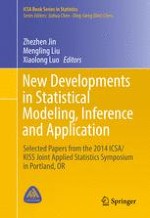The papers in this volume represent the most timely and advanced contributions to the 2014 Joint Applied Statistics Symposium of the International Chinese Statistical Association (ICSA) and the Korean International Statistical Society (KISS), held in Portland, Oregon. The contributions cover new developments in statistical modeling and clinical research: including model development, model checking, and innovative clinical trial design and analysis. Each paper was peer-reviewed by at least two referees and also by an editor. The conference was attended by over 400 participants from academia, industry, and government agencies around the world, including from North America, Asia, and Europe. It offered 3 keynote speeches, 7 short courses, 76 parallel scientific sessions, student paper sessions, and social events.
